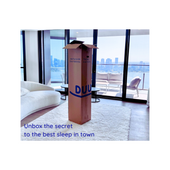They may be invisible to the naked eye, but dust mites are anything but benign. These tiny creatures thrive in the cozy confines of our bedding, upholstery, and carpets, feasting on our shed skin cells and leaving behind a trail of allergens that can trigger a range of symptoms.
From sneezing and coughing to itchy eyes and congestion, dust mite allergies can make life miserable for those sensitive to their presence.
And with millions of dust mites lurking in every corner of our homes, it's no wonder that allergies are on the rise.
But fear not—we're here to shine a light on these hidden intruders and empower you to take control of your indoor environment.
By understanding the causes and symptoms of dust mite allergies, you can create a healthier home that promotes well-being and comfort for you and your loved ones.
Microfiber Mayhem: Unveiling the Allergy Connection
Enter microfiber bedding, hailed for its affordability, durability, and easy care.
But beneath its smooth surface lies a potential minefield for allergy sufferers.
Microfiber, with its tightly woven fibers, can trap dust mites and their allergens, creating a breeding ground for discomfort and allergic reactions.
Unlike natural fibers like cotton and wool, which allow air to circulate freely, microfiber can lock in moisture and heat, providing the perfect conditions for dust mites to thrive.
And with regular laundering often insufficient to remove allergens from microfiber bedding, allergy sufferers may find themselves facing an uphill battle against their symptoms.
But fear not—we're here to help you navigate the maze of bedding options and make informed choices that promote a healthier, allergy-free sleep environment.
From hypoallergenic alternatives to regular cleaning routines, we'll share our top tips for minimizing dust mite exposure and maximizing your comfort.
Expert Tips for Allergy-Free Living
Choose Your Bedding Wisely
Opt for bedding made from natural fibers like cotton and wool, which are less likely to harbor dust mites and their allergens.
Look for products labeled as hypoallergenic or specifically designed to repel allergens for added peace of mind.
Frequent Washing
Maintain a regular washing routine for your bedding, washing in hot water (at least 55 degrees Celcius) weekly to kill dust mites and remove allergens effectively.
Consider investing in a mattress and pillow protectors to create an additional barrier against dust mites
Keep It Clean
Vacuum carpets, upholstery, and bedding regularly to minimize dust mite populations in your home.
Use a vacuum cleaner equippd with a HEPA filter to trap allergens effectively and reduce airborne particles.
Control Humidity Levels
Dust mites thrive in warm, humid environments, so keeping humidity levels in your home below 50% can help discourage their growth.
Consider using a dehumidifier in damp areas of your home to create a less hospitable environment for dust mites.
Invest in Allergy-Proof Bedding
Consider investing in allergy-proof bedding, such as mattress and pillow covers, to create a barrier against dust mites and their allergens.
These products are designed to prevent allergens from penetrating the surface, helping to minimize exposure while you sleep.
Dust mite allergies and microfiber bedding may seem like formidable foes, but armed with knowledge and proactive measures, you can reclaim control of your indoor environment and enjoy a healthier, more comfortable life.
By prioritizing allergy-friendly bedding options and implementing simple strategies to minimize dust mite exposure, you can breathe easier and sleep better night after night.


















































